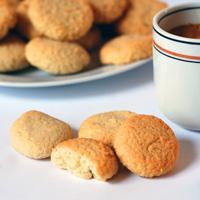
If you started a low-carb diet, or just thinking about starting, then you are probably worried about desserts. No more sugar? Nothing sweet to treat yourself to - ever? How can you cope?
Fear not! Sweet taste doesn't come from sugar alone - there are many sugar substitutes you can use instead. Some of them have little or no impact on your blood sugar and no calories, so you can safely indulge your sweet tooth without compromising your low-carb principles.
This article is the detailed guide to low-carb desserts - which ingredients to use, where to find them, types of low-carb desserts and, of course, links to recipes.
Low-carb desserts guide: - table of contents
Low-carb substitutions: Sweeteners instead of sugar | Nut flours instead of wheat flour | Sugar-free chocolate | Sugar-free extracts
Low-carb dessert recipes: Low-carb mousses and creams | Low-carb ice cream | Low-carb cheesecake | Low-carb cakes and biscuits | Low-carb brownies | Low-carb jelly | Low-carb truffles
Which desserts can I have on a low-carb diet?
Most traditional desserts are reasonably easy to adapt for low-carb ingredients. The only exception is recipes relying on sugar's chemical qualities rather than just its sweet taste - such as its ability to caramelise. But you should be able to adapt most traditional dessert recipes, using just a handful of substitutions as below.
Use low-carb sugar substitutes instead of real sugar
Erythritol is probably the best granulated sugar substitute for baking - it is often sold mixed with some Stevia. Popular brands of erythritol are , Swerve and . For most people, carbs in erythritol are not digestible at all, making it zero carb and zero calories.
Xylitol works really well for baking, but some of its carb content is digestible (around 10-20g of digestible carbohydrates per 100g, depending on the individual), so it has a much higher net carbs count than erythritol.
Liquid sweetener drops - some desserts work better with liquid sweeteners - the most common types are liquid sucralose and Stevia extract.
Read more in our guide to sugar substitutesUse nut flours instead of wheat flour
Nut-based flours are basically just very finely ground nuts, sometimes defatted to improve texture. The most popular ones are almond flour (or ground almonds) and coconut flour, but pretty much any nut can be ground up and used for this purpose. Ground flaxseed is also a popular ingredient, due to its wonderful nutritional profile. Nut flours do not contain gluten - the ingredient which makes traditional bread supple and light. So you would usually need to add something to make up for the absence of gluten - xanthan gum, guar gum and psyllium husks all work well in this capacity.
Read more in our guide to low-carb bakingUse sugar-free chocolate and cocoa powder
Did you know that chocolate is perfectly acceptable on a low-carb diet? Your enemy is sugar - not cocoa. Many well-known brands now produce unsweetened versions of their chocolate products, which you can use for baking, making desserts or making your own chocolate (it's fun!). If you can't be bothered with any of that, there are also some specialist products available, already sweetened with Stevia or another sugar substitute.
Read more in our guide to chocolate on a low-carb dietUse sugar-free flavourings and extracts
You can get sugar-free versions of extracts commonly used in baking, such as vanilla extract, or flavourings such as orange or almond extracts. These can be hard to find in supermarkets so you might have to look online or in specialist shops.
So what can you make with all these low-carb ingredients? The answer is almost anything! Some types of low-carb desserts are listed below, with links to recipes.

Low-carb cakes and biscuits
Low-carb baking is simpler than it sounds. The texture of low-carb cakes and other baked goodies won't be quite the same as the traditional ones - they are typically heavier and more dense - but not any less nice because of that. Just a little bit different.
Low-carb amaretti biscuits recipe | Low-carb chocolate cake recipe
Dessert recipes that are hard to convert to low-carb
Unfortunately, not all desserts are easy to make low-carb, for example, meringues and French macaroons, caramel and fudge. Usually this because sugar substitutes don't have quite the same chemical qualities as sugar - for example, they don't caramelise quite as well. Some people have tried to adapt these recipes, but it tends to be rather complicated. I would advise to stick to tried and tested desserts listed above, at least to start with, until you get a bit more experience and get used to the properties of low-carb ingredients.
Where to buy low-carb dessert ingredients
Although sugar-free products are slowly making their way to the shelves of mainstream supermarkets, your best bet would be health food shops and specialist retailers. Online shops tend to have a wider selection.
If you are based in UK or European Union, please do visit our online low-carb shop for a wide range of low-carb baking ingredients, sugar substitutes and sugar-free chocolate and cacao powder.
Impact on your weight loss
One word of caution - although these desserts are low in carbs, many of them are still quite high in calories. So if you overindulge, your weight loss could stall. As is the case with standard desserts, it is best to just have dessert occasionally as a treat, rather than every day or with every meal.
Finally, please also note that consuming too much sweetener can result in stronger sugar cravings in some people, as well as digestive upset. As always, moderation is the key. Just be sensible about how much you consume and watch out for any undesired effects.
Read more about the impact of sweetenersWhere to find more recipes
Low Carb Support on Google+ Carbophobic Twitter feed Popular low-carb recipe blogs

